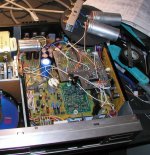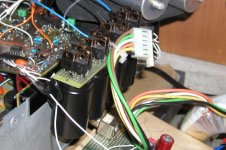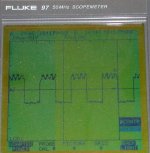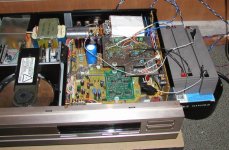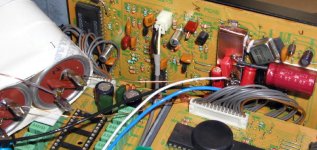Few more observations as I tweaked the thing.
I tried servo and I prefer coupling caps. Servo takes away fine detail and introduces a touch of something artificial. The caps I'm using are pretty good (Siemens MKV), but without the caps it's totally different level. Everything becomes much more coherent, crystal clear and smooth (it's like changing from AC power to batteries). However the DC offset isn't stable enough to remove the caps permanently. The DC level at amp's output varied from 20mV to 300mV and more.
Today I put the whole circuit inside the Marantz player (using the player's power supplies) and I was totally disappointed. The fine detail, relaxed presentation, smoothness, everything I liked about this DAC, was gone.
I tried servo and I prefer coupling caps. Servo takes away fine detail and introduces a touch of something artificial. The caps I'm using are pretty good (Siemens MKV), but without the caps it's totally different level. Everything becomes much more coherent, crystal clear and smooth (it's like changing from AC power to batteries). However the DC offset isn't stable enough to remove the caps permanently. The DC level at amp's output varied from 20mV to 300mV and more.
Today I put the whole circuit inside the Marantz player (using the player's power supplies) and I was totally disappointed. The fine detail, relaxed presentation, smoothness, everything I liked about this DAC, was gone.
Attachments
I tried choosing different points for taking raw supply for digtal (small improvements, but not to the point I remembered from before) . I tried using Kwack clock (instead of Raltron clock) for reclocking (didn't noticed major difference). Connected the outboard supply for digital part of a DAC, improvement but still not what it was in the beginning. I was almost ready to remove the board and use it as a separate DAC, like I had originally, when I decided to try one more option. I connected the external analog supply (for I/V stage). This supply consisted of toroid transformer, best Panasonic caps available and MUR860 diodes.
I put the music on and finally it sounded as I remembered it from previous day, maybe even better
Which leads to conclusion that analog supply in a CD player is pretty important. BTW, those caps were removed from top line Technics transport ($ 8,000) and it says for Audio on them. Those are the only caps I found so far that don't have the plastic jackets on them, but are painted black directly on the aluminum body. Would it be done this way for no reason?
__________________
I put the music on and finally it sounded as I remembered it from previous day, maybe even better
Which leads to conclusion that analog supply in a CD player is pretty important. BTW, those caps were removed from top line Technics transport ($ 8,000) and it says for Audio on them. Those are the only caps I found so far that don't have the plastic jackets on them, but are painted black directly on the aluminum body. Would it be done this way for no reason?
__________________
Attachments
So, in with this player I have no choice but add a separate, outboard PS for digital and analog stage of Rudol's board.
While I was testing I2S signal, this is what I observed on Fsync line coming out from SAA7210. Any idea how to fix it?
After reclocking, the signal is fine.
While I was testing I2S signal, this is what I observed on Fsync line coming out from SAA7210. Any idea how to fix it?
After reclocking, the signal is fine.
Attachments
Peter Daniel said:So, in with this player I have no choice but add a separate, outboard PS for digital and analog stage of Rudol's board.
While I was testing I2S signal, this is what I observed on Fsync line coming out from SAA7210. Any idea how to fix it?
After reclocking, the signal is fine.
Hi Peter,
Can you explain the problem? Some parts of the curve are hardly visible
Peter Daniel said:I would imagine that SAA7210 had to be connected to something else, otherwise it would be useless in a player
I'm not sure, but I think before installing Kwack clock the signal was fine.
Sure, Peter
But I asked if the 7210's I2S output was connected to something else that just the DAC.
Not the entiere chip, of course.
Bricolo said:??
The 7220 is only a digital filter. It won't give you digital out (if you mean spdif). It makes 4x (or 8x) I2S from a 1xI2S
the spdif interface uses another chip, 1825 or something like that
Wrong,
Pen 14 gives biphase-mark code output after interpolation, attenuation and muting. So before oversampling (obvious).
Read the datasheet.
GuidoB
Re: Next Version
glad to see some interest in the super pair, i would also consider a super pair for t5 as this current source has noticable output V swing and its cb junction nonlinearity could compromise the signal
rbroer said:In the next (and final) version I will add the "super-pair" as suggested by JCOX. Might as well give it a try, like I did for the CFP on my current boards.
glad to see some interest in the super pair, i would also consider a super pair for t5 as this current source has noticable output V swing and its cb junction nonlinearity could compromise the signal
Re: Re: Next Version
Initially I had a jfet cascode on T5.
But results from simulation showed no benefit doing this, so I left it out. I never compared with listening tests though.
I'll post my results in a couple of weeks when the new pcb's have arrived.

jcx said:
glad to see some interest in the super pair, i would also consider a super pair for t5 as this current source has noticable output V swing and its cb junction nonlinearity could compromise the signal
Initially I had a jfet cascode on T5.
But results from simulation showed no benefit doing this, so I left it out. I never compared with listening tests though.
I'll post my results in a couple of weeks when the new pcb's have arrived.
Here's update on my setup.
I managed to squeeze output caps inside player (wrapped in white tape at the back).
I cut the spaces on the board (as recommended by Rudolf) to devide digital section from analog ground plane and the improvement wasn't subtle. The feeling of being there and imaging improved.
As you see, I'm using batteries and I think it is improvement over the regualr supplies. The sound is much more coherent, more detail and better bass (also increased smoothness).
I used three 12V cells. The analog section gets the power bypassing the regulators. I plan to omitt LM 317 preregulator and connect 6V cell directly before low drop reg.
Also, I added 50ohm termination resistors (50 ohm) on the output of SAA7210 chip. According to Pete Goudreau, it was major improvement in his mods on a DAC. I also connected separate clock signal directly to the SAA7210 chip. When I listened after that change, I wasn't sure if it was an improvement. Somehow the sound lost it's immediacy and was more distant, less airy and image decreased somewhat. So I decided to introduce one more change. I disconnected the separate clock (running at 24xxxMhz and connected to reclocking circuit) and connected the main KC7 (inverted output) to reclocking circuit. Now, this made a major difference and things improved substantially.
I got the microdetail, air, space, feeling of being there, immediacy and everything became much more coherent. This seems to be the best version so far and the batteries will probably stay. When I switch back to regular power, it seems like the sound is polluted somehow.
Now I have to figure out a way to charge them in a smart way.
I managed to squeeze output caps inside player (wrapped in white tape at the back).
I cut the spaces on the board (as recommended by Rudolf) to devide digital section from analog ground plane and the improvement wasn't subtle. The feeling of being there and imaging improved.
As you see, I'm using batteries and I think it is improvement over the regualr supplies. The sound is much more coherent, more detail and better bass (also increased smoothness).
I used three 12V cells. The analog section gets the power bypassing the regulators. I plan to omitt LM 317 preregulator and connect 6V cell directly before low drop reg.
Also, I added 50ohm termination resistors (50 ohm) on the output of SAA7210 chip. According to Pete Goudreau, it was major improvement in his mods on a DAC. I also connected separate clock signal directly to the SAA7210 chip. When I listened after that change, I wasn't sure if it was an improvement. Somehow the sound lost it's immediacy and was more distant, less airy and image decreased somewhat. So I decided to introduce one more change. I disconnected the separate clock (running at 24xxxMhz and connected to reclocking circuit) and connected the main KC7 (inverted output) to reclocking circuit. Now, this made a major difference and things improved substantially.
I got the microdetail, air, space, feeling of being there, immediacy and everything became much more coherent. This seems to be the best version so far and the batteries will probably stay. When I switch back to regular power, it seems like the sound is polluted somehow.
Now I have to figure out a way to charge them in a smart way.
Attachments
Here's another update to my setup.
After experimenting with more simple setups recently I decided to redo the whole thing. All the boards went off and I started with a clean plate
I attached copper foilt to the SAA7210 and mounted TDA1543 directly to it (pins up). This allowed me to create I2S connection to be less than 1/2". I/V stage is passive with Rikens. I attached Tent clock to the digital board as well, and the local regulators are AN800x. All bypass caps are BG N. Raw supply is taken right after capacitors (for 5V) and from 14V regulation stage (for the DAC). The regulator on DAC is 8V. Coupling caps are Siemens MKV. No reclocking.
I prefer this setup to the previous one. It seems to present less of the digital artifacts. The biggest improvement is probably made by getting rid of those OsCons
After experimenting with more simple setups recently I decided to redo the whole thing. All the boards went off and I started with a clean plate
I attached copper foilt to the SAA7210 and mounted TDA1543 directly to it (pins up). This allowed me to create I2S connection to be less than 1/2". I/V stage is passive with Rikens. I attached Tent clock to the digital board as well, and the local regulators are AN800x. All bypass caps are BG N. Raw supply is taken right after capacitors (for 5V) and from 14V regulation stage (for the DAC). The regulator on DAC is 8V. Coupling caps are Siemens MKV. No reclocking.
I prefer this setup to the previous one. It seems to present less of the digital artifacts. The biggest improvement is probably made by getting rid of those OsCons
Attachments
- Status
- This old topic is closed. If you want to reopen this topic, contact a moderator using the "Report Post" button.
- Home
- Source & Line
- Digital Source
- Less simple I/V for TDA1543
